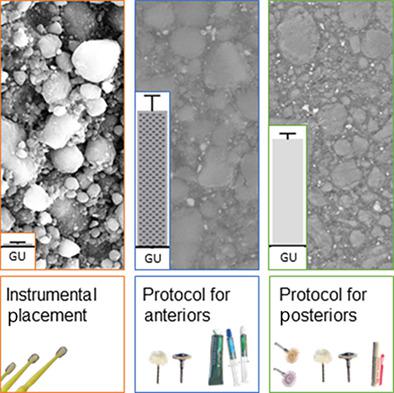当前位置:
X-MOL 学术
›
Microsc. Res. Tech.
›
论文详情
Our official English website, www.x-mol.net, welcomes your feedback! (Note: you will need to create a separate account there.)
Surface evaluations of a nanocomposite after different finishing and polishing systems for anterior and posterior restorations
Microscopy Research and Technique ( IF 2.5 ) Pub Date : 2021-06-09 , DOI: 10.1002/jemt.23850 Riccardo Monterubbianesi 1 , Vincenzo Tosco 1 , Giulia Orilisi 1 , Simone Grandini 2 , Giovanna Orsini 1 , Angelo Putignano 1
Microscopy Research and Technique ( IF 2.5 ) Pub Date : 2021-06-09 , DOI: 10.1002/jemt.23850 Riccardo Monterubbianesi 1 , Vincenzo Tosco 1 , Giulia Orilisi 1 , Simone Grandini 2 , Giovanna Orsini 1 , Angelo Putignano 1
Affiliation

|
This study aims to evaluate the effects of different finishing and polishing (F/P) systems on gloss and surface morphology of a new nanocomposite. Thirty discs of Filtek Universal Restorative material (3 M, ESPE) were prepared and divided into six groups (n = 5). Group A and B followed F/P protocols for anterior restorations, whereas Group C and D for posterior ones. Group E represented the control (covered by Mylar strip) and Group F represented the nanocomposite placement by means of clinical hand instruments; Groups E and F did not undergo F/P procedures. Among the polished groups, Group B showed the highest values (68.54 ± 7.54 GU), followed by Group A and D (46.87 ± 5.52 GU; 53.76 ± 2.65 GU). Finally, Group C (37.38 ± 4.93 GU) displayed the lowest results. Overall, Group E showed the highest gloss values (93.45 ± 8.27 GU), while Group F presented the lowest ones (1.74 ± 0.64 GU). Surface analysis revealed that Group A, C, and D displayed a smooth surface. Group B showed the lowest irregularities. Group E exhibited the most uniform superficial morphology. On the other hand, Group F displayed the most irregular one. In conclusion, using the tested material, only two protocols achieved appropriate gloss values. Then, clinicians might use the protocols of Group B and Group D, for anterior and posterior restorations, respectively.
中文翻译:

前后修复体不同修整和抛光系统后纳米复合材料的表面评估
本研究旨在评估不同精加工和抛光 (F/P) 系统对新型纳米复合材料的光泽和表面形态的影响。准备了 30 片 Filtek Universal Restorative 材料(3 M,ESPE)并分为六组(n = 5)。A 组和 B 组遵循 F/P 协议进行前牙修复,而 C 和 D 组遵循后牙修复。E 组代表对照(由聚酯薄膜条覆盖),F 组代表通过临床手持器械放置纳米复合材料;E组和F组未进行F/P程序。在抛光组中,B 组的值最高(68.54 ± 7.54 GU),其次是 A 组和 D 组(46.87 ± 5.52 GU;53.76 ± 2.65 GU)。最后,C 组 (37.38 ± 4.93 GU) 的结果最低。总体而言,E 组的光泽值最高(93.45 ± 8.27 GU),而 F 组的光泽值最低(1.74 ± 0.64 GU)。表面分析显示 A、C 和 D 组显示出光滑的表面。B 组的违规行为最少。E组表现出最均匀的表面形态。另一方面,F组表现最不规则。总之,使用测试的材料,只有两个协议达到了适当的光泽值。然后,临床医生可能会分别使用 B 组和 D 组的方案进行前牙修复和后牙修复。
更新日期:2021-06-09
中文翻译:

前后修复体不同修整和抛光系统后纳米复合材料的表面评估
本研究旨在评估不同精加工和抛光 (F/P) 系统对新型纳米复合材料的光泽和表面形态的影响。准备了 30 片 Filtek Universal Restorative 材料(3 M,ESPE)并分为六组(n = 5)。A 组和 B 组遵循 F/P 协议进行前牙修复,而 C 和 D 组遵循后牙修复。E 组代表对照(由聚酯薄膜条覆盖),F 组代表通过临床手持器械放置纳米复合材料;E组和F组未进行F/P程序。在抛光组中,B 组的值最高(68.54 ± 7.54 GU),其次是 A 组和 D 组(46.87 ± 5.52 GU;53.76 ± 2.65 GU)。最后,C 组 (37.38 ± 4.93 GU) 的结果最低。总体而言,E 组的光泽值最高(93.45 ± 8.27 GU),而 F 组的光泽值最低(1.74 ± 0.64 GU)。表面分析显示 A、C 和 D 组显示出光滑的表面。B 组的违规行为最少。E组表现出最均匀的表面形态。另一方面,F组表现最不规则。总之,使用测试的材料,只有两个协议达到了适当的光泽值。然后,临床医生可能会分别使用 B 组和 D 组的方案进行前牙修复和后牙修复。


























 京公网安备 11010802027423号
京公网安备 11010802027423号